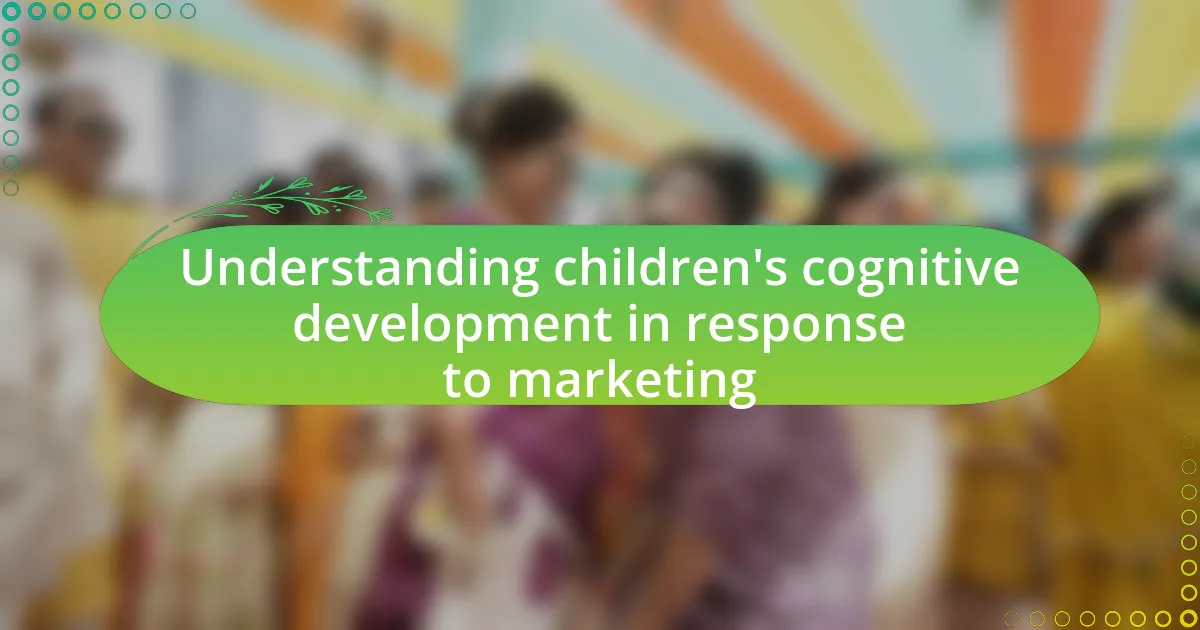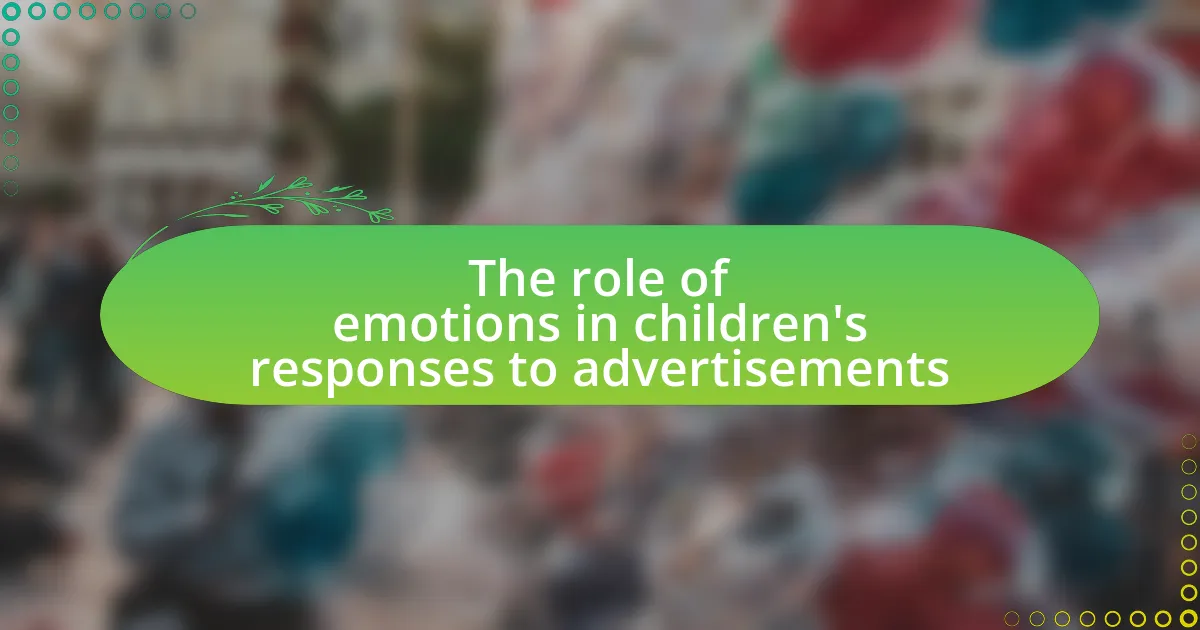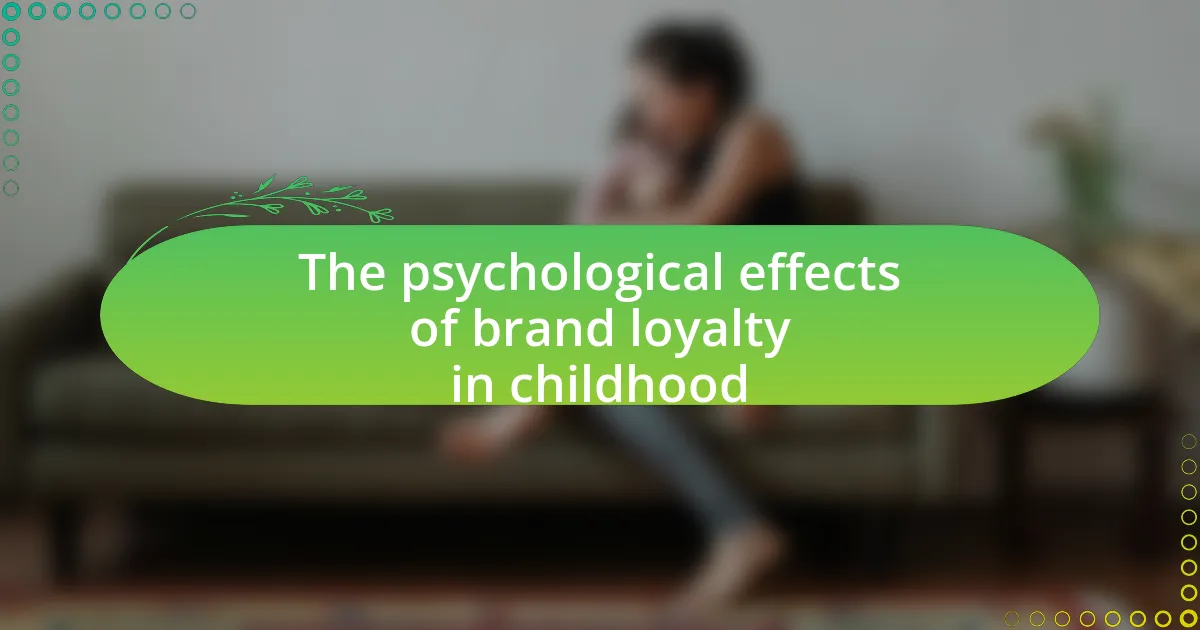Parental guidance is essential in shaping children’s exposure to advertising, as it helps them develop critical thinking skills and media literacy. The article explores how parents can mediate their children’s media consumption, enabling them to discern between entertainment and persuasive content. Key aspects discussed include the influence of parental discussions on children’s understanding of advertising techniques, the risks of unmediated exposure, and effective strategies for fostering a critical viewing environment. Additionally, the article highlights the long-term implications of parental involvement on children’s consumer behavior and brand perceptions.
What is the role of parental guidance in children’s exposure to advertising?
Parental guidance plays a crucial role in shaping children’s exposure to advertising by helping them develop critical thinking skills regarding marketing messages. Parents can mediate their children’s media consumption, teaching them to discern between entertainment and persuasive content. Research indicates that children who receive parental guidance are better equipped to understand the intent behind advertisements, leading to healthier consumption habits. For instance, a study published in the Journal of Advertising Research found that children exposed to parental discussions about advertising were more likely to question the credibility of ads and make informed choices. This guidance not only mitigates the potential negative effects of advertising but also fosters a more discerning approach to media literacy among children.
How does parental guidance influence children’s understanding of advertising?
Parental guidance significantly influences children’s understanding of advertising by shaping their critical thinking skills and media literacy. When parents actively discuss advertisements with their children, they help them recognize persuasive techniques and differentiate between entertainment and marketing. Research indicates that children who engage in conversations about advertising with their parents are better equipped to understand the intent behind ads and the strategies used to attract their attention. For example, a study published in the Journal of Advertising Research found that children exposed to parental discussions about advertising were more likely to question the credibility of advertisements and understand the concept of targeted marketing. This guidance fosters a more analytical approach to media consumption, enabling children to navigate advertising more effectively.
What are the key aspects of advertising that parents should explain to their children?
Parents should explain the persuasive techniques used in advertising, such as emotional appeals, celebrity endorsements, and targeted messaging. These techniques aim to influence consumer behavior and can create unrealistic expectations about products. For instance, research indicates that advertisements often use attractive models or celebrities to create a desire for products, which can lead children to associate happiness with material possessions. Additionally, parents should discuss the concept of advertising bias, where ads may present information selectively to promote a product, potentially misleading viewers. Understanding these aspects helps children critically evaluate advertisements and make informed decisions.
How can parents help children differentiate between advertising and content?
Parents can help children differentiate between advertising and content by actively discussing the purpose and techniques of advertisements. Engaging children in conversations about how ads are designed to persuade them can enhance their critical thinking skills. For instance, parents can point out specific elements in advertisements, such as catchy slogans or appealing visuals, and explain how these elements are used to attract attention. Research indicates that children as young as 3 years old can recognize advertising, but they may not fully understand its intent until they are older. By fostering an environment where children can ask questions and express their thoughts about what they see in media, parents can empower them to recognize the differences between promotional content and unbiased information.
Why is parental involvement crucial in mediating advertising exposure?
Parental involvement is crucial in mediating advertising exposure because it helps children develop critical thinking skills regarding marketing messages. Research indicates that children are particularly susceptible to advertising influences, often lacking the ability to discern persuasive intent. For instance, a study published in the Journal of Advertising Research found that children aged 8 to 12 are more likely to accept advertising claims as true without skepticism. By actively engaging in discussions about advertisements, parents can guide their children in understanding the motives behind marketing, thereby reducing the likelihood of being misled. This involvement not only fosters media literacy but also empowers children to make informed choices, ultimately mitigating the potential negative effects of advertising on their behavior and preferences.
What are the potential risks of unmediated advertising exposure for children?
Unmediated advertising exposure for children poses several potential risks, including the development of unhealthy eating habits, increased materialism, and diminished critical thinking skills. Research indicates that children exposed to food advertisements are more likely to choose unhealthy food options, leading to obesity and related health issues. A study published in the journal “Pediatrics” found that children who viewed more fast-food advertisements consumed significantly more calories than those who did not. Additionally, unmediated exposure can foster materialistic values, as children may equate happiness with the acquisition of products, which can affect their social relationships and self-esteem. Furthermore, without parental guidance, children may struggle to critically evaluate advertising messages, making them more susceptible to manipulation and less able to discern between reality and marketing tactics.
How does parental guidance affect children’s consumer behavior?
Parental guidance significantly influences children’s consumer behavior by shaping their attitudes and decision-making processes regarding purchases. Research indicates that children whose parents actively engage in discussions about advertising and consumer choices tend to develop critical thinking skills that enable them to evaluate marketing messages more effectively. For instance, a study published in the Journal of Consumer Research found that children who received guidance from their parents were more likely to question the intent behind advertisements and make informed choices, rather than impulsively buying products. This demonstrates that parental involvement not only affects immediate purchasing decisions but also fosters long-term consumer literacy in children.
What strategies can parents use to guide their children’s exposure to advertising?
Parents can guide their children’s exposure to advertising by implementing strategies such as co-viewing media, discussing advertising techniques, and setting limits on screen time. Co-viewing allows parents to engage with their children while watching advertisements, enabling them to explain the intent behind ads and promote critical thinking. Discussing advertising techniques, such as persuasive language and imagery, helps children understand how ads are designed to influence their choices. Setting limits on screen time reduces the overall exposure to advertisements, which is crucial since studies indicate that children are particularly susceptible to advertising messages, with research showing that children aged 2 to 11 see an average of 25,600 commercials per year. These strategies collectively empower children to navigate advertising more effectively.
How can parents create a critical viewing environment for advertisements?
Parents can create a critical viewing environment for advertisements by actively engaging their children in discussions about the content and intent of ads. This involves explaining the persuasive techniques used in advertising, such as emotional appeals and celebrity endorsements, which can help children understand that advertisements are designed to influence their purchasing decisions. Research indicates that children who receive guidance from parents are better equipped to critically analyze advertisements, leading to more informed consumer behavior. For instance, a study published in the Journal of Consumer Research found that parental involvement significantly enhances children’s ability to recognize advertising tactics, thereby fostering critical thinking skills related to media consumption.
What role does open communication play in discussing advertising with children?
Open communication is essential in discussing advertising with children as it fosters critical thinking and media literacy. When parents engage in open dialogues about advertisements, children learn to analyze and question the messages being presented, which helps them differentiate between persuasive techniques and factual information. Research indicates that children who participate in discussions about advertising with their parents are better equipped to understand the intent behind ads and are less likely to be influenced by misleading claims. For instance, a study published in the Journal of Advertising Research found that children who received parental guidance on advertising were more skeptical of marketing tactics, leading to healthier consumption habits. This underscores the importance of open communication in empowering children to navigate the advertising landscape effectively.
How does parental guidance vary across different age groups?
Parental guidance varies significantly across different age groups, reflecting the developmental needs and cognitive abilities of children. For infants and toddlers, guidance primarily focuses on creating a safe environment and limiting exposure to advertising, as they are unable to critically evaluate content. As children enter preschool and early elementary years, parents begin to introduce discussions about advertising, teaching them to recognize persuasive messages. Research indicates that children aged 4 to 7 are particularly susceptible to advertising, necessitating more active parental involvement in mediating exposure. In middle childhood, parents shift towards fostering critical thinking skills, encouraging children to question advertisements and understand their intent. By adolescence, parental guidance often transitions to discussions about media literacy and the impact of advertising on self-image and consumer behavior, as teenagers develop the ability to analyze and critique media content. This progression aligns with studies showing that effective parental mediation can reduce the influence of advertising on children’s purchasing behaviors and attitudes.
What specific challenges do parents face when guiding younger children?
Parents face several specific challenges when guiding younger children, particularly in the context of advertising exposure. One major challenge is the difficulty in effectively communicating the persuasive intent of advertisements, as younger children often lack the cognitive skills to critically analyze marketing messages. Research indicates that children under the age of eight are particularly susceptible to advertising, as they do not fully understand the difference between entertainment and marketing (Nairn & Fine, 2008). Additionally, parents struggle with the overwhelming presence of digital media, which exposes children to a constant stream of advertisements across various platforms, making it harder to monitor and regulate their exposure. Furthermore, parents often find it challenging to instill values of critical thinking and media literacy in their children, as they may not have the tools or knowledge themselves to navigate the complexities of modern advertising.
How can guidance strategies evolve as children grow older?
Guidance strategies can evolve as children grow older by shifting from direct supervision to fostering independence and critical thinking. As children transition from early childhood to adolescence, parents can gradually reduce their involvement in decision-making, encouraging children to analyze and question advertising messages. Research indicates that older children possess enhanced cognitive abilities, allowing them to understand persuasive techniques used in advertising, which necessitates a more nuanced approach to guidance. For instance, studies show that adolescents are better equipped to recognize advertising intent, prompting parents to engage in discussions about media literacy rather than simply restricting exposure. This evolution in guidance strategies supports children’s development of autonomy while equipping them with the skills to navigate advertising effectively.
What are the implications of parental guidance on children’s long-term attitudes towards advertising?
Parental guidance significantly shapes children’s long-term attitudes towards advertising by influencing their critical thinking and media literacy skills. When parents actively engage in discussions about advertisements, children develop a more discerning perspective, enabling them to recognize persuasive techniques and evaluate the credibility of marketing messages. Research indicates that children who receive consistent parental guidance exhibit lower susceptibility to advertising, as they learn to question the motives behind promotional content. For instance, a study published in the Journal of Advertising Research found that children with informed parents were 30% less likely to be influenced by misleading advertisements compared to their peers. This demonstrates that effective parental involvement can foster a healthier skepticism towards advertising, ultimately leading to more informed consumer behavior in adulthood.
How does parental guidance shape children’s brand perceptions?
Parental guidance significantly shapes children’s brand perceptions by influencing their attitudes and understanding of products. Parents serve as primary role models, and their preferences, discussions, and attitudes towards brands directly impact how children perceive those brands. Research indicates that children often adopt their parents’ brand preferences, as demonstrated in a study by McAlister and Cornwell (2010), which found that parental influence is a key factor in children’s brand loyalty and recognition. This guidance helps children develop critical thinking about advertising, as parents can contextualize marketing messages and teach children to evaluate brands based on quality and value rather than mere appeal.
What impact does parental guidance have on children’s purchasing decisions in the future?
Parental guidance significantly influences children’s future purchasing decisions by shaping their values, preferences, and understanding of consumerism. Research indicates that children who receive consistent guidance from their parents develop critical thinking skills regarding advertising and marketing, leading to more informed purchasing choices later in life. For instance, a study published in the Journal of Consumer Research found that children whose parents actively discussed advertising messages were better equipped to discern persuasive tactics, resulting in more thoughtful consumer behavior as adolescents. This demonstrates that parental involvement not only affects immediate purchasing decisions but also instills long-term consumer literacy.
What best practices can parents adopt for effective guidance in advertising exposure?
Parents can adopt several best practices for effective guidance in advertising exposure by actively engaging in discussions about advertisements with their children. This includes explaining the purpose of advertising, helping children understand persuasive techniques, and encouraging critical thinking about the messages conveyed. Research indicates that children who engage in discussions about media content with their parents develop better media literacy skills, which can lead to more informed decision-making regarding advertising. For instance, a study published in the Journal of Advertising Research found that parental involvement significantly enhances children’s ability to recognize advertising intent and differentiate between content and commercials. By fostering an open dialogue and providing context, parents can empower their children to navigate advertising more effectively.






